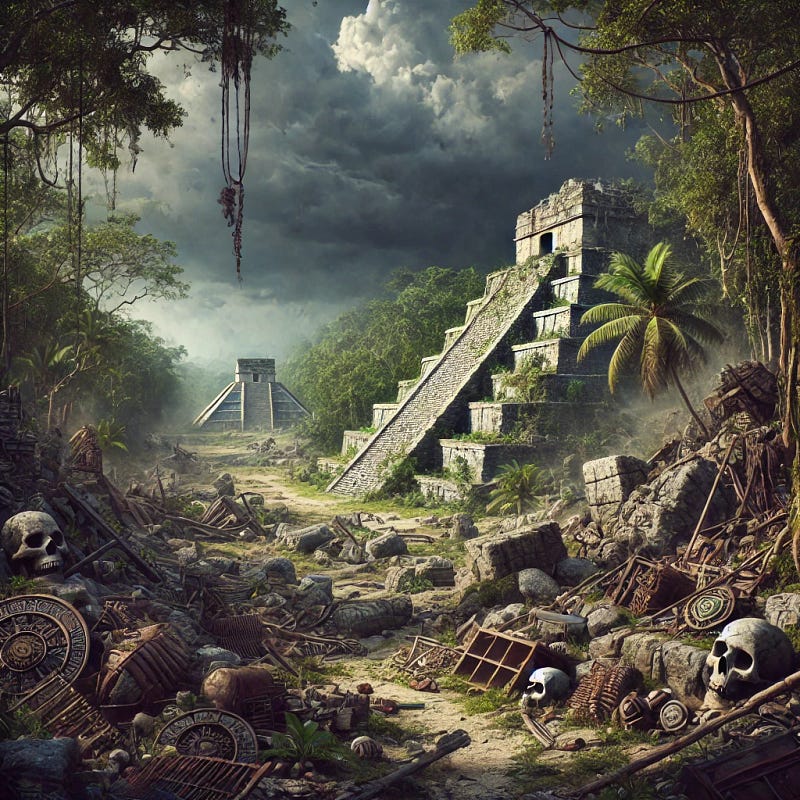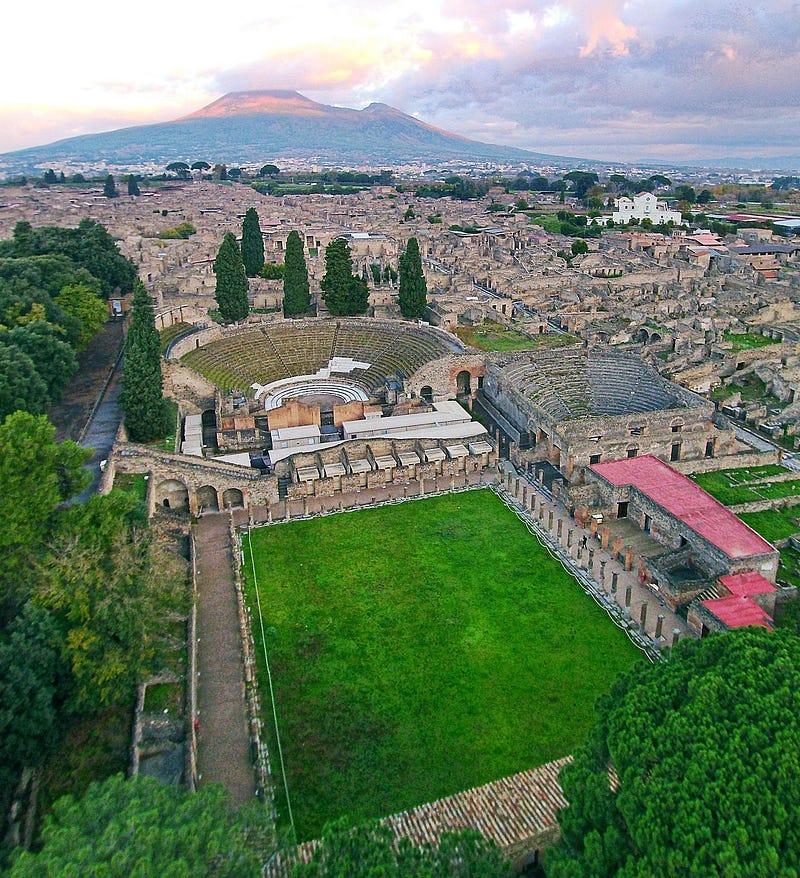Exploring Environmental Changes and Their Impact on Civilizations
Written on
Chapter 1: The Interconnection Between Environment and Civilization
As summer arrives, the intensity of the heat is striking. It seems that the tradition of staying indoors is increasingly becoming a summer norm. This shift in behavior serves as a potent reminder of the ongoing transformations within our climate and surroundings. Since the beginning of human civilization, we have been subject to the mercies of nature, and history illustrates how societies have thrived or crumbled in response to environmental shifts.
But how does this influence our identity? Do we heed the warnings left by those who came before us? Daily, we engage with our environment, often overlooking the long-term effects of our actions. Our relentless pursuit of resources and advancement frequently comes at the expense of the natural world we rely on. By examining the challenges and successes faced by ancient peoples, we can navigate the environmental issues present in our lives today.
The Collapse of the Mayan Civilization
The Mayan civilization, consisting of numerous city-states, is renowned for its advancements in mathematics, astronomy, and architecture. Emerging around 2000 BCE and declining by 900 CE, the Mayans are often misunderstood as a unified entity; in reality, they operated as a collection of independent city-states. At their zenith, they shared cultural and religious ties, despite political fragmentation. Their impressive pyramids, intricate calendar systems, and complex written language reflect their sophisticated society. Unfortunately, they failed to anticipate the environmental repercussions of their practices, leading to their downfall.
The Mayans confronted significant environmental hurdles that contributed to their decline. The slash-and-burn farming techniques employed in the Yucatán Peninsula led to extensive deforestation. Initially effective, this approach resulted in severe soil erosion over time, diminishing agricultural yields. As urban populations swelled, the demand for resources surged, putting immense pressure on already strained agricultural systems. This imbalance culminated in food shortages and famine, exacerbated by prolonged droughts during the Late Classic period, which further decimated crop production.

The environmental degradation had far-reaching political and social effects. As resources dwindled, political instability arose, leading to tensions among the city-states as competition for scarce supplies intensified. With widespread food shortages, many urban centers became unsustainable, prompting inhabitants to abandon them in search of better living conditions. Nature gradually reclaimed these abandoned cities, shrouding them in dense jungle.
The fall of the Mayan civilization exemplifies how environmental mismanagement and climate change can destabilize even the most advanced societies. Their experiences remind us of the fragile equilibrium between human actions and the natural world, emphasizing the necessity of sustainable practices to ensure the survival of civilizations.
The Role of the Nile River in Ancient Egypt
Few rivers have had as profound an impact on human history as the Nile. Stretching over 4,000 miles, it has consistently provided water in a dry region, turning it into a vibrant oasis. One key factor in its resilience is the annual flooding that enriches the land with nutrients, which was crucial for the development of ancient Egyptian society. This reliable resource allowed Egyptians to establish one of history's most enduring civilizations, supporting agriculture, trade, and cultural unity.

The Nile's annual floods, known as inundations, were vital for agricultural productivity. From June to September, the river overflowed, depositing nutrient-rich silt onto the surrounding areas, transforming arid land into fertile farmland capable of yielding abundant crops. This regular cycle ensured a surplus of goods, facilitating the emergence of a complex society complete with centralized governance, specialized labor, and monumental architecture.
Moreover, the Nile greatly influenced the worldview of the ancient Egyptians. The stability provided by dependable food sources was reflected in their religious beliefs and cultural practices, with the river viewed as a divine blessing. This reverence fostered societal unity and maintained order, contributing to the civilization's longevity. The predictability of the Nile's floods allowed the Egyptians to focus on cultural and technological advancements, such as pyramid construction, development of a written language, and innovations in medicine and engineering.
The Nile was essential to the success and longevity of ancient Egyptian civilization. Its annual floods provided the ecological stability needed for sustained agricultural production, while the Egyptians' innovative responses ensured their prosperity for millennia. The river's significance in trade, communication, and cultural evolution underscores its unparalleled role in human history.
The Effects of Volcanic Eruptions on Ancient Civilizations
The menacing image of a volcano is often viewed as an omen of destruction. Throughout history, volcanic eruptions have significantly impacted civilizations, causing immediate devastation and long-lasting societal changes. A notable instance is the eruption of Mount Vesuvius.
Mount Vesuvius has erupted multiple times, but the most infamous event occurred in 79 CE, which led to the obliteration of Pompeii and Herculaneum. This catastrophic eruption transpired swiftly, and Pliny the Younger, a Roman author, documented the devastation in detail. His uncle, Pliny the Elder, tragically lost his life while attempting to assist those trapped in the cities. Pliny the Younger’s account has led to the classification of this eruption as a Plinian eruption.

The immediate effects of Vesuvius’s eruption were catastrophic. Thousands perished in Pompeii and Herculaneum, unable to escape the fast-moving pyroclastic flows and ash. The cities were buried under meters of volcanic material, preserving their structures, artifacts, and even the victims' remains. This preservation offers invaluable insights into Roman life, effectively freezing these cities in time. The long-term consequences were equally significant; the displacement of survivors disrupted regional economies and trade networks, impacting lower Italy for years. The loss of these vibrant cities dealt a severe blow to the area's economic and social structure. Furthermore, the eruption served as a stark reminder of nature's power, prompting Roman engineers to consider natural disaster risks more seriously in their future projects.
The eruption of Mount Vesuvius in 79 CE had immediate and devastating effects, destroying entire cities and claiming thousands of lives. The long-term consequences included economic turmoil and a heightened awareness of natural disaster risks, influencing Roman engineering and urban planning. This event serves as a powerful testament to the destructive power of volcanoes and their enduring impact on human civilization.
Conclusion
The interplay between environmental factors and human progress is critical. Historical instances—the decline of the Mayan civilization, the Nile River's role in ancient Egypt, and the catastrophic eruption of Mount Vesuvius—offer valuable insights into how environmental changes have shaped societies. The Mayans faced dire consequences due to unsustainable agricultural practices and deforestation, which ultimately led to their civilization's collapse. Conversely, the Nile's contributions to Egypt's stability facilitated the unification of its culture and religion. The eruption of Vesuvius illustrated the immediate and lasting effects of natural disasters on societies.
Understanding these environmental transformations and their impacts on ancient civilizations is essential for recognizing the delicate balance between human endeavors and the natural world. As we confront increasingly extreme weather and climate patterns, it becomes evident that neglecting our environment carries dire consequences. We are not masters of nature; rather, we are subject to its whims, and failing to address these challenges can lead to severe repercussions.
Modern society stands to gain important insights from how ancient civilizations adapted to and were affected by environmental changes. The Mayans' experiences underscore the risks of environmental mismanagement, while the stability of ancient Egypt highlights the advantages of sustainable practices. The story of Pompeii serves as a cautionary tale regarding the necessity of disaster preparedness and resilient infrastructure.
As we reflect on today’s ecological issues, we must heed the lessons of our forebears. Sustainable environmental practices are imperative; we cannot continue to exploit nature without facing repercussions. It is crucial to prioritize responsible resource management, invest in disaster preparedness, and develop technologies aimed at mitigating climate change impacts. Learning from the past can provide a pathway for a thriving future.
For further history articles like this one, subscribe to my newsletter.
Click here to sign up for Cody Trusler’s newsletter.
Follow me on X for more updates!
The first video titled "Debates About the ENVIRONMENT After 1900 [AP World History Review, Unit 9 Topic 3]" explores significant environmental discussions and changes from 1900 to the present.
The second video, "Effects of Globalization on the ENVIRONMENT [AP World History Review—Unit 9 Topic 3]," examines how globalization has influenced environmental conditions and challenges.